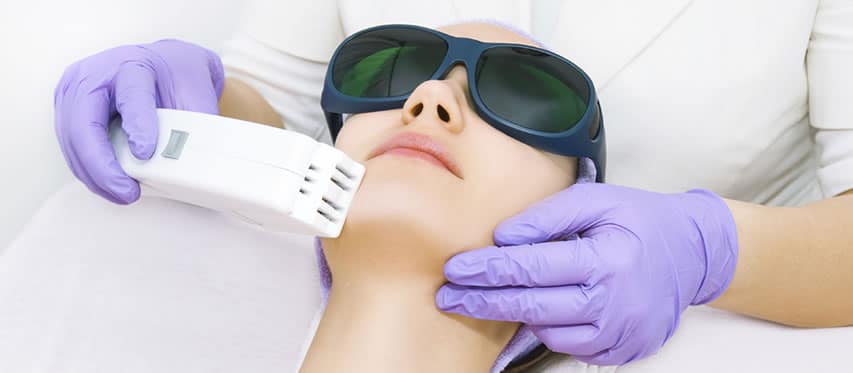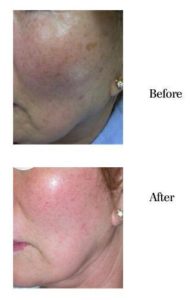IPL Photo Rejuvenation in Sarasota, FL

Intense Pulsed Light therapy (IPL) also referred to as a photo facial, is a versatile light based skin rejuvenation treatment designed to address a number of skin concerns. All IPL treatments are performed by Dr. Plush at our Sarasota, FL location.
What is IPL?
Our Lumenis® One™, Intense Pulse Light (IPL) uses specialized light waves to target and correct a wide range of common skin problems. IPL therapy is ideal for recovering “sun worshippers” wishing to improve their skin after years of sun damage. It is among the gentlest, non-ablative skin treatments that offers dramatic rejuvenation results in a short time.
What skin concerns will The IPL Laser Treat?
IPL is a highly versatile treatment that can be used safely to treat the face, neck, chest and hands and is an appropriate solution for the following skin concerns:
- Hyper pigmentation
- Sun Damage
- Rosacea
- Broken Capillaries
- Age/brown spots
- Freckles
- Red or Ruddy Skin
- Enlarged Pores
- Lines
- Uneven texture
WHAT TO EXPECT DURING THE TREATMENT?
Your IPL treatment may take from 20 minutes to 90 minutes depending on your treatment plan. Due to the short duration of the procedure, you should not require the application of a topical anesthetic. You will require protective eyewear, though, which your provider will give to you before your treatment begins. During the procedure, you can expect to feel momentary snapping or pinching sensations as the light permeates through your skin. These sensations last just seconds. The first few may feel surprising, but most people get used to them after a minute or two, after which they are only mildly uncomfortable. IPL is not described as painful. You may feel a warm, tingly sensation as the deeper layers of your skin are warmed and stimulated to produce more collagen.
WHAT IS THE DOWNTIME WITH LASER SKIN TREATMENT?
You do not need to schedule time off to have IPL treatment done. That said, you can expect to look sunburned for up to six hours following your appointment. Knowing this, you may not want to plan to go right back to the office. Slight swelling and bruising can also occur. We expect these side effects to resolve in 12 to 24 hours. It is possible to apply makeup right after an IPL treatment. However, it is difficult to guarantee that this will completely hide all immediate effects. After your redness has resolved, the spots that have been targeted by the IPL procedure may get darker. Again, these may not be fully disguised with makeup. So that you can plan your recovery period, it is important to know that crusting and flaking can continue for up to 10 days.
HOW CAN I PREPARE FOR IPL TREATMENT?
When you schedule any cosmetic treatment, you want to get the very best results. We want that for you, too! Before your IPL treatment, you can help prepare your skin for optimal recovery and regeneration by ensuring that you stay well-hydrated. Yes, drink more water. And also, talk to Dr. Plush about the best products to use on your skin to adequately increase moisture retention.
IS THERE ANYTHING I SHOULD AVOID BEFORE IPL TREATMENT?
The number one thing to avoid before undergoing IPL treatment is sun exposure. We know, that can be challenging around here! Even if you must enjoy some outdoor time each day, you can adhere to this guideline by applying broad-spectrum SPF 30 sunscreen daily and by wearing protective clothing. If you plan to have IPL treatment on your face, wear a wide-brimmed hat when you go outside. If you’re having treatment done on your neck or chest, wear a scarf or high-necked shirt.
HOW LONG WILL IT TAKE BEFORE I SEE RESULTS?
Your body will be working to dissolve the pigmentation that has been targeted and to regenerate healthy new tissue for several days after your IPL treatment. For about a week, the dark spots or other pigment concerns may darken and crust. So, while your body is correcting the problems we’ve treated, it may take about one week for you to see the benefits of your decision to undergo IPL.
IS THERE ANYTHING I SHOULD AVOID AFTER IPL TREATMENT?
After your IPL treatment, you should avoid a few things. These include:
- Direct, unprotected sun exposure. Wear broad-spectrum, SPF 30 sunscreen and protective clothing.
- Dry skin! Be diligent about applying the recommended moisturizer.
- Exfoliating. It is important to allow the crusts that form to fall off naturally.
- Harsh chemicals. Avoid the use of Retin-A, benzoyl peroxide, and glycolic acids.
- Picking and rubbing. Again, it’s important to allow crusts to fall off naturally. Otherwise, you may see unwanted light or dark spots.
Is there pain associated with IPL skin rejuvenation?
You may experience a light stinging sensation that is usually well-tolerated by most people.
How long does an IPL treatment last?
An IPL treatment typically takes 20 minutes depending on the size of the area being treated.
What Are the side effects?
The most common side effect is redness in the treated area that usually disappears within a few hours. Mild to moderate swelling can develop within the first few days following treatment. Other potential side effects include bruising, blistering, scabbing, and changes in the skin’s pigmentation.
What is the recovery time?
You will need to avoid sun exposure and wear sunscreen for a couple weeks after treatment in order to protect your skin as it heals. The skin may appear flushed for a few days after IPL and spots may become darker. The dark spots will slowly fall off within 10 to 14 days. After a few weeks, your skin will look brighter, clearer, and more youthful.
How Many Treatments will I need?
Treatment varies depending on the severity of your condition. Typically 3 to 5 treatments, at 2-4 week intervals will produce the desired results. 1-2 maintenance treatments per year are recommended to preserve your results.
See Other IPL Patient Questions Dr. Plush has Answered
Comparing IPL to Other Skin Rejuvenation Technologies
Intense pulsed light (IPL) therapy is one of several non-invasive skin rejuvenation options available today. Compared to laser skin resurfacing, IPL uses multiple wavelengths of light instead of a single focused beam. This allows it to treat a variety of skin concerns — such as pigmentation, redness, and sun damage — across larger areas of skin with less intensity and downtime. Laser resurfacing, while effective, typically involves more recovery time and is often used for deeper wrinkles or severe texture irregularities.
LED therapy, on the other hand, uses specific wavelengths of light to stimulate collagen or reduce inflammation but is generally gentler and more suitable for maintenance or mild concerns rather than dramatic results. Microdermabrasion is a mechanical exfoliation technique that only addresses the surface layer of the skin. While it can improve texture and tone, it does not address pigmentation or vascular issues the way IPL does.
IPL stands out for its ability to treat multiple conditions simultaneously with minimal discomfort and quick recovery, making it a versatile and cost-effective solution for many patients.
The Science Behind IPL Technology
IPL therapy uses broad-spectrum light delivered in controlled pulses that target specific chromophores in the skin. These chromophores — such as melanin in brown spots and hemoglobin in blood vessels — absorb the light energy, which is then converted into heat. This heat damages the unwanted pigments without harming the surrounding tissue. Over time, the body eliminates the treated pigment or vessel, revealing clearer, more evenly-toned skin.
The versatility of IPL lies in its ability to use filters that narrow the light spectrum to focus on different skin concerns. For example, different wavelengths may be selected to treat redness from rosacea, freckles, age spots, or acne. The ability to customize each treatment session makes IPL an adaptable and powerful tool in skin rejuvenation.
Who Is a Good Candidate for IPL?

Patients with active acne, certain skin conditions like eczema or psoriasis in the treatment area, or a history of keloid scarring may be better suited for alternative cosmetic treatments. Your consultation at American Dermatology Associates will include a full skin assessment to determine candidacy and create a tailored plan that best achieves your goals.
Long-Term Care and Maintenance After IPL
While IPL produces impressive improvements, maintenance is key to preserving those results. Once your treatment is complete, you can probably benefit from follow-up sessions every 6–12 months, depending on your skin goals and lifestyle.
Long-term success also depends on a consistent skincare routine, including daily sunscreen use, hydration, and topical antioxidants. Limiting sun exposure and scheduling regular dermatology checkups will help prolong the benefits of treatment and ensure ongoing skin health.
Ready to Rejuvenate Your Skin with IPL?
Dr. Plush is an internationally-recognized dermatologist with years of experience in advanced skin rejuvenation treatments, including IPL therapy. At American Dermatology Associates in Sarasota, Florida, you receive expert care rooted in evidence-based medicine and a commitment to lasting results. Contact (941) 379-6647 to schedule your personalized consultation.

